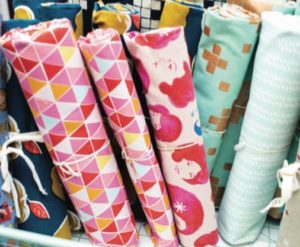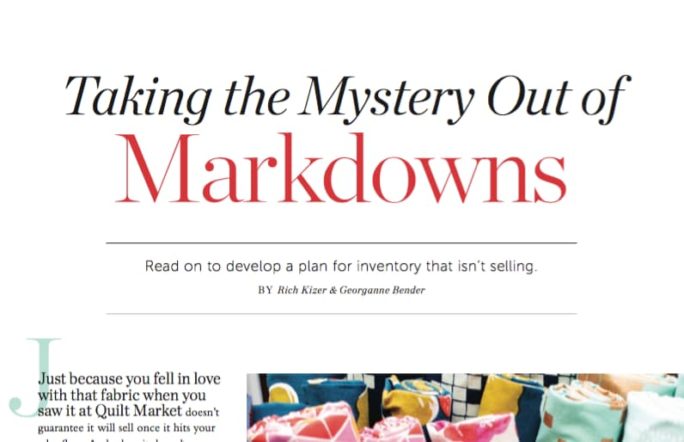Read on to develop a plan for inventory that isn’t selling.
 Just because you fell in love with that fabric when you saw it at Quilt Market doesn’t guarantee it will sell once it hits your sales floor. And when it doesn’t you need a plan to get rid of it so you can buy fabric that will sell. Let’s take a look things you can do to move merchandise that isn’t selling:
Just because you fell in love with that fabric when you saw it at Quilt Market doesn’t guarantee it will sell once it hits your sales floor. And when it doesn’t you need a plan to get rid of it so you can buy fabric that will sell. Let’s take a look things you can do to move merchandise that isn’t selling:
What’s Your Turn?
Inventory turnover—turn—is a measure of the number of times inventory is sold within a period of time, usually a year. To determine your inventory turnover, simply divide your last year’s total retail sales by your year ending inventory at retail value. To improve your turn rate you must closely control your inventory. Be firm about delivery dates, and implement a strong markdown program to clear out product that’s past its sell date.
Control Your Delivery Dates
Yes, you can tell vendors when you want to receive your orders. But you have to ask, so before you place an order decide when the product actually needs to be in the store and then tell your vendors what you need. It makes no sense to take late-season deliveries if that will hurt you, and it’s just as foolish to receive goods—and have to pay for them—far in advance of your actual need time. So request delivery dates. You won’t always get your wish, but if you don’t ask, the vendor will always get theirs.
If markdowns are not taken in time it will take much larger discounts to create value. Just ask
a retailer who’s trying to sell Halloween costumes at full price in December.
Know When to Take a Markdown
Retailers tend to think of markdowns the enemy, but in reality it is smart business to clear out what isn’t selling. To be blunt here, stores do not go out of business because they had to take markdowns; they close when product is not selling fast enough to create the cash ow needed to cover expenses.
When done on time, the first markdown you take is always the cheapest markdown. Clearing merchandise before the price/value relationship is destroyed is critical— you should mark down items as soon as sales start to slow down.
Let’s say you have an item that’s currently priced at $25.00 but it isn’t selling. If you mark that item down to $19.99, its value goes up in the customer’s mind. If markdowns are not taken in time it will take much larger discounts to create value. Just ask a retailer who’s trying to sell Halloween costumes at full price in December. Feel secure in knowing that markdowns allow you to maximize your invested dollars; when you get those dollars back you can reinvest into newer items that will yield higher margins and better inventory turn.
As you walk your sales floor each day be consistently on the lookout for merchandise that’s past its prime and mark it down accordingly. Sales on seasonal merchandise should begin just before the season ends. If you wait to take markdowns until after the season or holiday is over you will severely hurt your return. Customers will make these soon to be out of season purchases at other stores at markdown better pricing. And packing product away for next year isn’t a good idea either because it never looks as fresh as it looked when it was initially received. Get the cash out of your investment and keep it working with new, fresh goods.
Where to Display Markdown Merchandise
When you run a sale, run a SALE. Display the product near the front of the store or in its normal home. You can also use your speed bump displays to house this merchandise during the sale. Highlight the displays with banners, balloons or signs created specifically for the sale. Too many clearance areas look like disaster zones and that’s no way to create value. Clearance items should be merchandised with the same care as regularly priced product. When running a clearance sale, display this product near the front of the store. After the sale move it to a clearly marked clearance area near the rear of the store. You house it at the back of the store so shoppers have to pass through displays of new product to get to it. Clearly sign your clearance area so that shoppers will want to stop and check it out before heading to the cash wrap.
Look at every piece of merchandise and every display on your sales floor as if it’s a pile of cash, because that’s what it is. No matter how much you love it, if a product isn’t selling, it has to go to make room for something that will.
Rich Kizer and Georganne Bender are consumer anthropologists, speakers, authors and consultants. Find more great articles from Kizer and Bender here!






